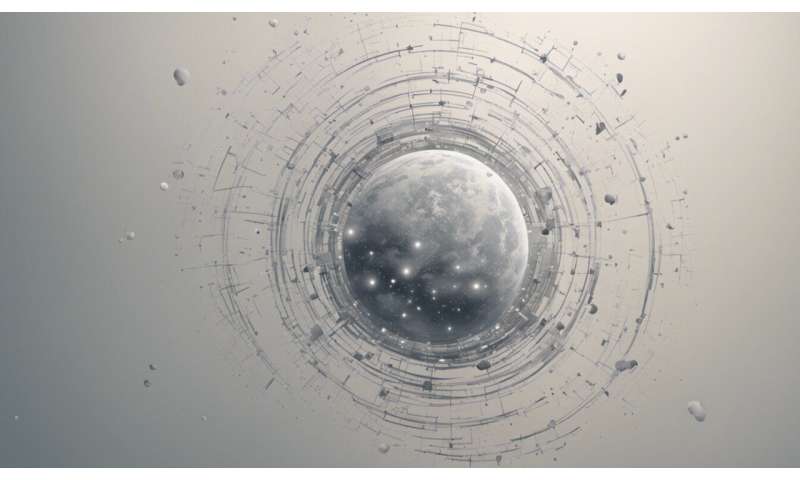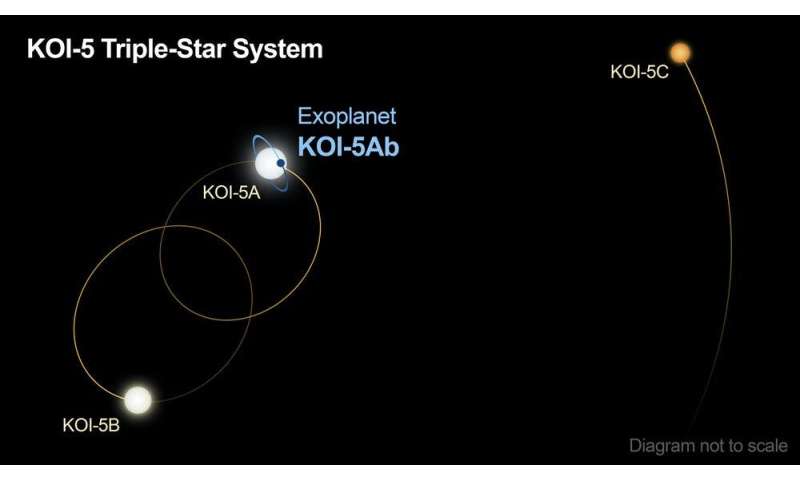Previously thought to be science fiction, a planet in a triple-star system has been discovered

KOI-5Ab is a newly discovered planet in a triple-star system. It is a great example of the kind of astonishing discoveries that result from co-operation between large teams of astronomers using different types of telescopes and observation techniques.
There is a stereotype that "lone genius" scientists make discoveries without any help from others. This is propagated by the prestigious Nobel Prize, which is awarded to at most two or three scientists at a time.
But major discoveries, particularly in the fields of astronomy and physics, are increasingly achieved by teams of dozens or even hundreds of scientists combining data from multiple experiments and observation techniques.
How to find an exoplanet
One of the fastest-growing areas of astronomy research is the study of planets in other solar systems, called exoplanets. As of this writing, 4,367 exoplanets have been discovered. Trying to observe an exoplanet orbiting around a distant star is a bit like trying to see a firefly crawling on a searchlight, so the vast majority of exoplanets have been discovered using a variety of clever indirect techniques.
One of these is the radial velocity technique, which has been used to discover 833 exoplanets so far. This technique measures tiny shifts in the color of light from the star as it is gently tugged by its orbiting exoplanet.
Most of the early exoplanet discoveries were made using this technique. The first tentative detection of an exoplanet was by a Canadian team in 1988 using radial velocity. The first definite discovery of an exoplanet in 1995 earned the discoverers the 2019 Nobel Prize in Physics.
Radial velocity was first, but now more than three-quarters of the known exoplanets have been discovered using the transit technique. This technique works by measuring a star's brightness over time, watching for regularly repeated drops in brightness, which could be caused by a planet passing in front of a star during its orbit.
Thousands of planets
The Kepler Mission carefully measured the brightness of 180,000 stars every one to 30 minutes for four years using a space-based telescope. Almost 2,400 exoplanets were discovered (and over 400 more in the follow-up K2 mission). The Kepler Mission Team officially includes dozens of astronomers and support scientists, and dozens more were able to analyze the publicly available data for additional planetary discoveries.
The Kepler Mission measured its last exoplanet in 2018, and now the Transiting Exoplanet Survey Satellite (TESS) is following in its footsteps. Instead of focusing on a single patch of sky, TESS monitors several patches of sky.
The downside to the simple transit technique is that there are other astrophysical effects that can cause the same periodic drop in brightness, like background stars that vary in brightness, or starspots (like sunspots). Because of this, when interesting signals are first discovered by transit surveys, they are dispassionately numbered as "objects of interest" until they are validated as real exoplanets by another exoplanet detection technique, often radial velocity.
Right now, the TESS mission has more than two thousand objects of interest and over 100 confirmed exoplanets. The validation process is where many of the really surprising, fascinating exoplanetary systems are teased apart by impressive feats of scientific collaboration and cooperation, and the TESS and Kepler teams maintain a coordination center to plan and share follow-up data.
Amazing exoplanet systems
Some of the really remarkable exoplanet discoveries to date include planets that orbit around a pair of stars (yes, like Tatooine in Star Wars), seven exoplanets in the same system all closer to their star than Mercury is to our sun, evaporating planets and a brown dwarf with rings that puts Saturn's to shame.
All of these discoveries required a lot of additional modeling and data collection in order to understand the systems, but one of the most complicated exoplanet systems yet was announced in January 2020.
Kepler Object of Interest 5 (KOI-5) was one of the first batch of possible exoplanets sent down by the Kepler space telescope in 2009. But the first follow-up data quickly showed the system was complicated by an additional star and weird follow-up observations. Mission astronomers were gleefully (and perhaps slightly frantically) wading through possible exoplanet discoveries, so it was put aside and the data was left in the public archive. The same system was flagged again a decade later by TESS as a TESS Object of Interest (TOI-1241).

High-resolution imaging by one team of astronomers was combined with longer time baseline radial velocity data from another team and the story began to emerge: KOI-5 was a triple-star system with an exoplanet orbiting one of the stars. This discovery was presented at the January 2021 American Astronomical Society meeting, and a peer-reviewed paper is forthcoming.
I have been a user of various public data archives for exoplanet systems in my research and work, and I fully appreciate how open data policies maximize the scientific research output that can be accomplished with each dataset.
Complex orbits
Two sun-sized stars, designated A and B, orbit each other every 29 years in the middle of the system, while a third, smaller star orbits the two central stars every 400 years. The discovered planet is called KOI-5Ab, because it orbits star A, on an orbit that is tilted wildly away from the plane of the stars' orbits.
Data from Kepler and TESS, which required the effort of dozens of astronomers working together, has revealed the size of KOI-5Ab: seven times the radius of the Earth. Another team of astronomers used radial velocity data to measure the mass of KOI-5Ab: 57 times the mass of the Earth. Combining these numbers gives the density, and tells us this planet is a gas giant planet, a bit smaller and denser than Saturn.
As someone who became an astronomer because I've always loved reading science fiction stories, I like thinking about what it would be like to visit an exoplanet like this. Being a gas planet, we couldn't actually stand on the surface, but if we could hover on the edge of its atmosphere with our spaceship, what would we see?
A few exoplanets have been measured to be very dark, so imagine looking down to see dark brown and gray clouds swirling in turbulent stripes driven by ferocious winds. In the sky, you would see one sun, 17 times larger than our sun. There would also be another much smaller sun, only half a percent as bright as our sun (which would still be a thousand times brighter than the Earth's full moon). This smaller sun would complete an orbit through the constellations in the sky every thirty years. The third star in the system would move much more slowly relative to the background stars, and despite its large distance, would still appear much brighter than the full moon in our sky.
Even in orbit over this planet, full darkness would only be available for brief snatches every couple hundred years when all three stars wandered into the same portion of the celestial sphere. This exoplanet system sounds like a science fiction story, but astronomers have been able to conclusively prove its existence.
Collaborative discovery
Astronomy is one of the better sciences for sharing data. We have the arXiv repository of freely accessible peer-reviewed papers, and standard practice is for telescope data to be publicly accessible in various databases after a short (usually one year) proprietary period.
The co-operation between astronomers using many different observation techniques has led to incredible discoveries like the KOI-5Ab system, and as long as satellites do not ruin ground-based astronomy, large team efforts and collaborations between telescope facilities will continue to produce astronomical discoveries remarkable enough to surpass science fiction.
This article is republished from The Conversation under a Creative Commons license. Read the original article.![]() This story is part of Science X Dialog, where researchers can report findings from their published research articles. Visit this page for information about ScienceX Dialog and how to participate.
This story is part of Science X Dialog, where researchers can report findings from their published research articles. Visit this page for information about ScienceX Dialog and how to participate.